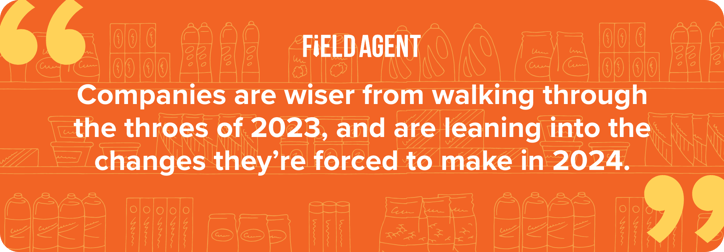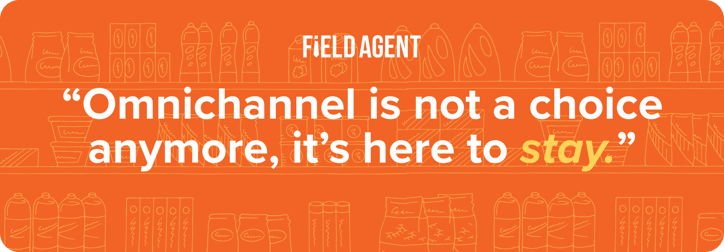The beginning of a new year—especially in the CPG and retail industry—brings unknowns. Will this year look like last? Is something coming that we just can’t see?
We sat down with Co-Founder and CEO of Field Agent, Rick West, to hear his thoughts on the general state of the industry, as well as trending topics in the media for shelf-level insights.
Looking Behind (2023) and Planning Ahead (2024)
“The word I use for 2023 is lukewarm. It consisted of indecisiveness with an unreliable economic state while still dealing with COVID aftereffects. As we're coming into 2024, COVID is in the rear view mirror and we have a better understanding of where interest rates are going to stand. However, we can’t forget that it's an election year.
With this informed insight of the socioeconomics coming in 2024, it’s apparent that now, just weeks into 2024, companies are saying, ‘I'm not going to operate within these temporary vague parameters,’ as opposed to, ‘Maybe, it'll go away at the end of the year.’

Reality has set in, and companies are now forced to make plans around the instability of our economic standing. Companies are wiser from walking through the throes of 2023, and are leaning into the changes they’re forced to make in 2024.
At this point, no one is going to get a pass for the wait-and-see approach to doing business. That’s what 2023 was known for. We can no longer wait and see for new item launches, purchasing necessary items, and investing. By default, the US has been putting traditional business on hold and now must deal with our new reality.”
Making Room for the Omnichannel and Hybrid Shopping Experience
“Specifically from the retailer perspective, the omnichannel experience will shift yet again.
If I look at just the hybrid shopping experience alone, shoppers are going to continue to want every option. Retailers could find themselves having to pivot once again. In 2022 and 2023, we saw that many top retailers moved their staff from front checkout lanes to accommodate labor in online pickup and delivery. They thought, ‘I don't really need to change my back room. We can deal with this temporarily.’
And now, based on the work we're seeing at Field Agent, many retailers are actually coming to the conclusion that the hybrid shopping experience is not going to go away. Shoppers expect stellar customer service and short wait times in line, in store. Yet, they also expect quick pickup and same-day delivery. The way retailers are staffing and operating backrooms must change. The omnichannel experience has heightened in the past year to make way for the new way of grocery and retail shopping.
We see this in the impacts of labor rates, staffing shortages, and customer experience by retailers moving registers to self-serve and reallocating staff to pickup and delivery.
We’re watching the same trends unfold in the Quick Service Restaurant (QSR) space. With minimum wage rates rising, you see front end workers being replaced with kiosks and self-service checkouts that eliminate the need for human interaction. Think about your local McDonald’s. Many now have implemented the large two-sided, touchscreen kiosks that take your order, take your payment, and give you a number — seems like a bit much when you only want a single drink, but this is where things are going.

So from my perspective, omnichannel is not a choice anymore, it’s here to stay. It’s imperative for retailers, brands, and restaurants to meet their shoppers where they want to shop. At Field Agent, we’re honored to help this transition by providing feedback from real shoppers.
The Shopper’s Preference
“Coming from ‘23 to ‘24, we can’t fight the way that consumers want to shop — or in some cases, the way that retailers want them to engage in their stores. For example, the shopper now has a larger role to play in the retail experience: bagging their own groceries, ordering their own food, using self-checkout lanes, etc.
We will start to notice in local Walmarts, Targets, Costcos, etc, an upgrade in technology to make way for a faster, easier, more reliable self-checkout experience. One thing that retailers have not yet found a perfect solution for is the impact of theft at each self-checkout station. What will be the impact on the overall shopping experience, and will prices will also start to reflect the impact of theft at retail?
This somewhat “forced” hybrid shopping experience reminds me of a thought from the economist Thomas Sowell. He once said, ‘There are no solutions. There are only trade-offs.’

I agree with Sowell. With the shopper’s new ‘all-modes-all-the-time’ preference, it’s just a series of trade-offs for most complex problems. It’s not an ultimate answer. That's what retailers are facing. At the end of the day, will the consumer take the brunt of longer waits, higher prices, and more individual labor in exchange for the convenience of pickup, delivery, and online shopping.”
AI in Daily Life
“If you're a startup or a small brand, AI (artificial intelligence) is going to change the way you do work in 2024. For example, instead of needing a full team, you will be able to shift some work to tools that are AI driven.
Your staff can then focus on the complexities of the business rather than being consumed with small tasks.
Within the upcoming technology landscape, you’ll have a hard time finding a software that does not include AI. It’s almost like the table stakes or the ante: in order to be a part of the conversation, you have to have as part of your pitch that you use AI.
The larger companies and big players in AI are going to be faced with legality and red tape as we continue to push the boundaries of what’s possible. In order to use the creative licensure and impressions for artificial intelligence collateral, brands will now have to get subscriptions and permissions. We’ve seen it most recently with the New York Times and Disney characters.
However, we’ll see how it continues to learn and grow alongside our culture. AI enhances productivity and generates general content. For the public and the corporate lens alike, we’re on ground zero for what’s to come.”
Workforce Restructuring
“The riffs you’re seeing in workforce restructuring today is what you should have had a year or two ago, but the COVID money that companies received allowed them to push off payroll reduction. This played into companies delaying their workforce reduction… until now.
Companies realize they can't keep the workforce they once had.
The other piece playing in the restructuring game is the strain on the venture funded, private equity funded companies in the open market.
Valuations were once at ten to twenty times revenue and VC’s funded companies accordingly. When you look at where we are today, much of that funding has been burned through. In today’s world, instead of getting valuations of 10 to 20, the valuations are three to six or four to eight. So as valuations come down, companies can no longer just spend and have a deficit — they’ve got to be profitable now to make the funding last longer.
We saw an entire ecosystem of startups and tech companies that now have to be profitable that as little as two years ago, profitability was not even part of the conversation.
I go back to one of my favorite sessions from All-In with Chamath, Jason, Sacks & Friedberg, a podcast on the tech industry and global markets.
‘Funding over the next decade freaks me out. You have to keep business capitalized,’ Sacks said. ‘Companies have to shift from making longer time cycle investments that may not pay off for many years… to shifting towards making things that’ll generate real profitability and revenue in the near term. Keep expense costs low, and building from there.’
‘The biggest trend I’m seeing is outsourcing of talent. They’re all looking for ‘What’s the most efficient way for me to build a team?’ We have to get to breakeven with the money we just got, we’re not expecting a second round of funding,’ they mentioned. ‘We talk about AI as a disrupter to companies, but AI might be the biggest disrupter to venture capital in the end.’
Hiring employees and hoping for traction for series funding is now a pressure cooker. However, with the same money, you can have employees offshore, paying less, and now have more time for return. You’re seeing massive layoffs, some 80% have reduced up to 40% of our companies. It’s mandatory to be profitable now.
They see this in their portfolio companies and have adjusted their investment philosophy accordingly.”
Sustainability and Better-For-You Products
“I predict that companies in 2024 are going to be required to legitimately vet spokespeople to vouch for their products. Shoppers will buy from someone they can trust.
A great example? Plant-based products. You have to find influencers and marketing professionals that are in the environment every day. Consumers now want to know how to best spend their limited time and money—both of which need to go further than ever. Shoppers rarely try products any more without a recommendation from someone they can trust, or the ratings and reviews on products online.
Consumers want to know: are you willing to stake your reputation on it?
For new sustainably-packaged, better-for-you, specific-ingredient-free products that have a higher price tag, they need to have extensive concept testing and ratings and reviews before they can succeed in the open market.”
Ensure Your Product’s Success in 2024
In this uncertain market, don't let your product's fate be left to chance.
Ensure your success in 2024 with Field Agent's comprehensive data and insights. From in-store shelf assessments to online ratings and reviews, we provide the granular detail you need to understand your consumers' experience and optimize your product strategy. We partner with the AI-powered Shelfgram platform that aggregates visual data to deliver clear insights into product placement, on-shelf availability, and shopper attention.
Get ahead of the curve and reach out to Field Agent today to discuss how we can tailor a solution that meets your specific needs.


